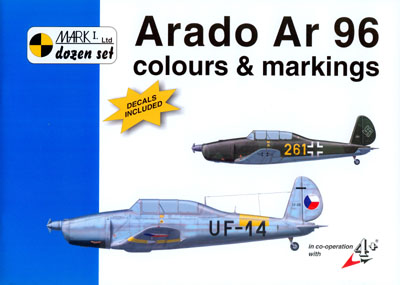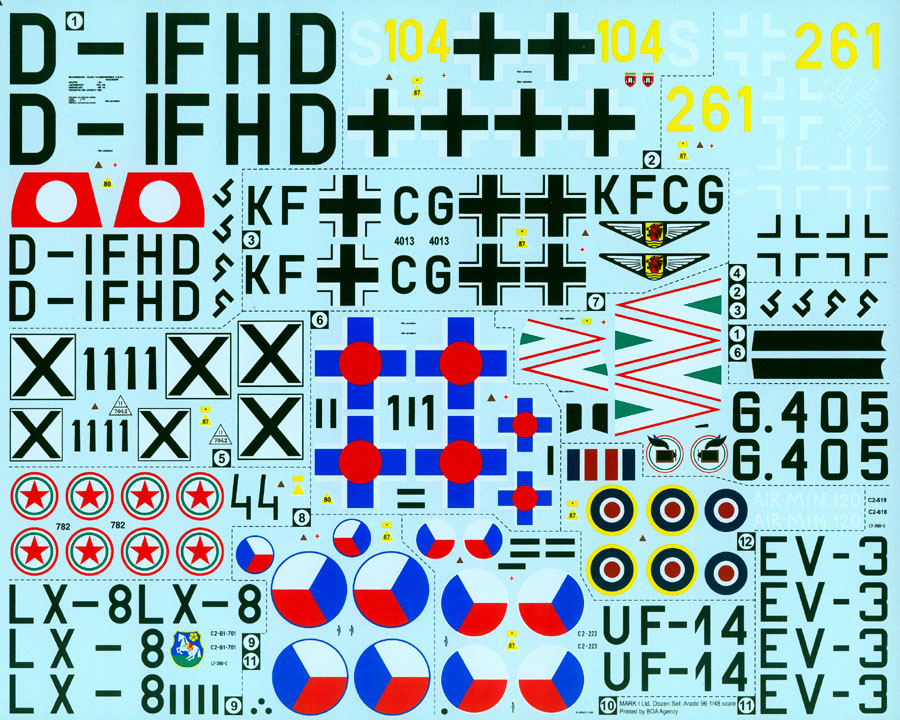
Arado Ar 96 Colours & Markings
By Chris Banyai-Riepl
Author: Michal Ovcacik & Karel Susa
Publisher: Mark I. Ltd
ISBN: 978-8086637-10-5
Binding: Softbound
Pages: 28
The newest title in the Colours and Markings series by Mark I covers a rather attractive aircraft, the Arado Ar 96. For those not familiar with this series, the book could be considered an expanded decal sheet. There are a dozen individual aircraft covered, and a comprehensive decal sheet is included for each of these aircraft. For each of these aircraft, there is a page of photos and a page of drawings, with each aircraft illustrated in at least one photo. The drawings are a complete four-view shaded color illustration, showing both marking placement and weathering.
The first four aircraft are all German (understandable, as this is a German aircraft). The first one is the Ar 96V2, D-IFHD. Three photos show this plane in 1937. Next up is an Ar 96B-3 from JFS 3 in 1942. Two photos illustrate this aircraft, and a third photo of a different Arado shows some of the nose gun details of the B-3 variant. The third German option is an Ar 96B-1 from FFS A/B 71 in 1942, and is coded KF+CG. This aircraft has a yellow cowling and yellow rudder, and one photo documents the plane. The final Luftwaffe example is a camouflaged Ar 96B-3 from JFS 2 in 1942. A single photo documents Yellow 261's RLM 70/71 over RLM 65 camouflage.
 Moving on to the foreign operators, the first country up is Bulgaria, with an Ar 96B coded Black 11. A single photo shows this aircraft in green over blue camouflage, with yellow wingtips and a yellow fuselage band. Slovakia is next, with an overall silver gray Ar 96A-1 coded Black 1. The large crosses are easily identifiable in the single photo of this aircraft. The Hungarian options number two, with the first wearing the early chevron markings from 1940. Coded G.405, this aircraft is overall silver gray, with a unit emblem on the fuselage sides. One photo shows this aircraft, while another photo shows a different Ar 96 with the later tri-color bands on the tail. The second Hungarian option is a post-war Ar 96 (actually a Czech-built Letov C-2B1) in an overall aluminum finish and coded Black 4. This aircraft carries the new red star national insignia in eight positions. A single photo shows this aircraft after a landing accident.
Moving on to the foreign operators, the first country up is Bulgaria, with an Ar 96B coded Black 11. A single photo shows this aircraft in green over blue camouflage, with yellow wingtips and a yellow fuselage band. Slovakia is next, with an overall silver gray Ar 96A-1 coded Black 1. The large crosses are easily identifiable in the single photo of this aircraft. The Hungarian options number two, with the first wearing the early chevron markings from 1940. Coded G.405, this aircraft is overall silver gray, with a unit emblem on the fuselage sides. One photo shows this aircraft, while another photo shows a different Ar 96 with the later tri-color bands on the tail. The second Hungarian option is a post-war Ar 96 (actually a Czech-built Letov C-2B1) in an overall aluminum finish and coded Black 4. This aircraft carries the new red star national insignia in eight positions. A single photo shows this aircraft after a landing accident.
Czech examples are next, with the first being an Avia C-2B1, LX-8, in overall aluminum. The single photo shows this aircraft in flight with two other aircraft, with a unit emblem on the nose. The second Czech example is also overall aluminum, but has broad yellow bands on the wings and upper rear fuselage. Coded UF-14, two photos show this aircraft after a wheels-up landing in a field. The third Czech option is a Letov C-2B1 coded EV-3. Two photos show this aircraft, one parked at an airfield and another showing another wheels-up landing (hey, it's a trainer, that's to be expected in training pilots, right?). Finally, the last option is an Ar 96B-7 captured by the British and given the AIR MIN 120 number on the rear fuselage. The German markings were painted out and RAF roundels and fin flashes were applied. A single photo illustrates this aircraft.
Also interspersed throughout the book are detail photos of a museum Ar 96, showing many areas of interest for the modeler. A two-page spread covers the cockpit, both in photos and drawings, which will be of great use, considering how big that canopy is. Overall, this is an excellent little reference on the Arado Ar 96, and coupled with the high quality decal sheet (it's packed, but printing is excellent and register is outstanding, even on the small decals), this is a book well worth tracking down. My thanks to Mark I. Ltd. For the review copy.
